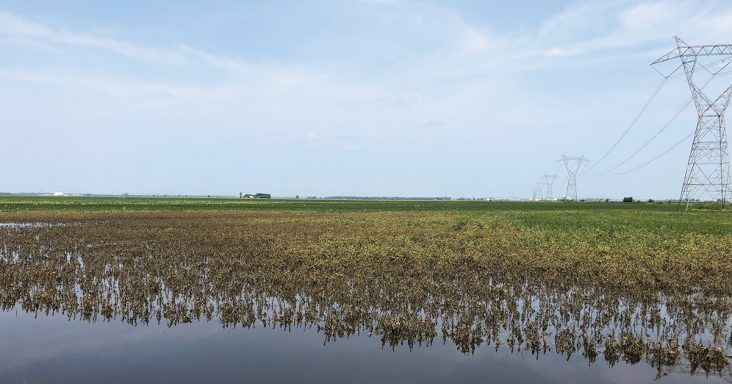Crop-eating insects may have ridden Barry into the Arkansas Delta
by July 17, 2019 1:55 pm 865 views

Tropical Storm Barry slung bands of rain in Arkansas on Saturday (July 13) and continued to inundate the state through Tuesday, dropping more than eight inches of rain in parts of eastern and southwest Arkansas, closing and washing out some roads, and spurring flash flood warnings. And, Barry brought more than water and wind. The tropical system might have also hastened the flight of crop-hungry insects from the south.
“We know that Louisiana is loading up with red banded stink bugs and we’re finding a few in extreme southern Arkansas,” said Chad Norton, extension soybean and wheat verification coordinator for the University of Arkansas System Division of Agriculture. “How many more were ‘blown’ into the state by Barry? We fought these in 2017 and had a very difficult time in controlling them.”
Norton said soybean loopers may also have hitched a northbound ride on Barry. The expectation is that the the insects could arrive earlier than normal and it could cause insecticide prices to spiral upwards, he said. Weeds could also be worse due to the tropical storm.
“Our crop is late compared to normal, we now have had a weather system that could have made the insect populations worse and we’re already having large corn earworm moth flights,” he said.
“This much rain is just washing our soil-applied herbicides out of the fields,” Norton said. “These residual type herbicides are the backbone of our weed control strategies for pigweed. I’m afraid that we’re now going to get a big flush of pigweeds and we won’t be able to get back in the fields in a timely manner to control them due to the wet soil conditions.”
The cotton crop had been doing relatively well until the storm hit. But, it blotted out the sun and it could mean trouble for cotton.
“We are worried about cloudy weather at a time a plant needs sunshine to produce energy needed to keep boll load,” said Bill Robertson, extension cotton agronomist. “This will likely lead to massive shedding of fruit. Cooler weather will help soften the impact. We have a late crop so lost fruit will be hard to make back up.”
The water wasn’t all bad. Robert Goodson, Phillips County extension agent for the Division of Agriculture, said there were many places in his coverage area that needed water. Rain water will help save farmers on irrigation costs that spike during this time of the growing season. The rain is still causing some issues, especially in low-lying areas, he added.
“Area drains are beginning to fill up and with the hard rain we are getting now, some low-lying areas might have water standing in them. So far, there has been no damage with the storm, but that could change if this hard rain continues for an extended period of time,” he said.
Agents and agronomists said lingering moisture may also increase disease pressure in the fields.
Matthew Davis, Jackson County extension agent for the Division of Agriculture, said “The slow pace of the rainfall has kept everything from becoming too overwhelmed. Most guys had prepared for this rain by cleaning ditches, opening gates and ditching.”
In his county, low-lying areas would be an issue. “It’s really too late to replant anything and there are still many acres of soybeans not planted. We assume at this point no further planting will happen.”
Relief may be on the way according to predictions by the National Weather Service. NWS predicts it will be dry and hot in most of the Arkansas Delta throughout the next five days. There’s a slight chance of a popup thunderstorm in Northeast Arkansas on Wednesday (July 17), but there’s little chance of rain after that through Sunday (July 21).
